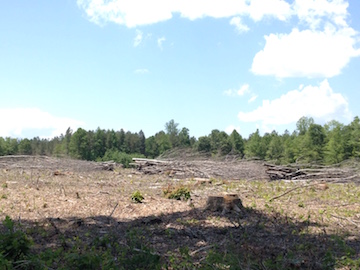A Word on Behalf of Preservation from the Banks of the North Anna
 On the evening of May 26, the Army of the Potomac pulled away from the North Anna River. With a feint to the west, the army juked back east and swung across the Pamunkey toward the Totopotomoy.
On the evening of May 26, the Army of the Potomac pulled away from the North Anna River. With a feint to the west, the army juked back east and swung across the Pamunkey toward the Totopotomoy.
Before we leave the North Anna, it’s worth taking one last look around.
Henegan’s Redoubt clings to the lip of the steep north bank of the river, hiding in the treeline, nearly invisible. A field of barley spread out in front of it looks ready to crowd in and push the old earthwork over the edge. The stalks stand straight as soldiers with spikey plumed hats. Or maybe they’re a multitude of bayonet tips.
 The barley fills the fields on both sides of Oxford Road, but just two-tenths of a mile to the west, on the road’s north side, the barley gives way to a woodlot. 152 years ago, Federal soldiers moved through the area as they executed a pincer movement on the redoubt.
The barley fills the fields on both sides of Oxford Road, but just two-tenths of a mile to the west, on the road’s north side, the barley gives way to a woodlot. 152 years ago, Federal soldiers moved through the area as they executed a pincer movement on the redoubt.
Not long ago, the trees there grew thick as the Wilderness, but today, I see that someone has clear-cut the lot over the winter. The weathered wood pulp that remains has blanched gray.
A thin line of trees still stands, separating this post-apocalyptic landscape from the comforting green field of grain.
The woodcutting stretches for a few miles along the north side of the road. It’d seen it farther west last year, but it has crept closer to Route One—and Henegan’s Redoubt on the south side of Oxford Road—over the past months.
What will eventually go there? A housing development? More farm field? A replanted wood lot?
A trip down to the county planning office might tell me something, but I’m out here to battlefield this day. But now I’m a-wondering.
Preservation is much on my mind as I tromp battlefields. North Anna represents a collection of great success stories. In 2014, of course, there was the huge score by the Civil War Trust, which acquired 665 acres at Jericho Mills on the western end of the battlefield. And Hanover County’s North Anna Battlefield Park would not exist had local government officials not worked with a local gravel company to set aside the core of the Confederate line leading out to Ox Ford. The gravel company even donated the gravel used to pave the hiking trails. It’s been an excellent partnership all the way around.
 But a trip to that park today offers a reminder of how fragile the battlefield can still be. Where once a visitor entering the park would see the old gravel pits to the left, the company has now expanded across the driveway and has begun digging to the east. Two hulking pieces of heavy equipment sat quiet on the anniversary of the battle, but it was obvious that work on the expansion was well underway.
But a trip to that park today offers a reminder of how fragile the battlefield can still be. Where once a visitor entering the park would see the old gravel pits to the left, the company has now expanded across the driveway and has begun digging to the east. Two hulking pieces of heavy equipment sat quiet on the anniversary of the battle, but it was obvious that work on the expansion was well underway.
These all serve as keen reminders of the important work that the Civil War Trust and other local and regional preservation organizations do every day. (Let me give a shout-out to my own local preservation group, the Central Virginia Battlefields Trust, while I’m at it.)
We can take nothing for granted. Even here along the banks of the North Anna River, out in rural Virginia where one might assume that development pressures haven’t blossomed, there’s always the chance that something could disappear.
We must always remain vigilant—because even when we’re looking, things can slip away.
Excellent story well written many thanks Chris
My pleasure. Thanks so much for reading!
One of the most important things ECW does is keep the cause of Battlefield Preservation front & center. It is just as important for us to “take the field” now as it was for the men who fought over the same field 150+ years ago. Huzzah!
Hemlocks survive at Ox Ford! Preservationists and conservationists of all stripes, please be aware of the presence at Ox Ford of a grove of hemlocks, apparently un-infested by the woolly adelgid which is chewing its way up the Appalachians and has wiped out Virginia’s hemlocks, except for a few isolated stands. The grove at Ox Ford is one of only three I know of east of the Blue Ridge–the other 2 being on the South Anna and Little River. These are ice age remnants that I hope will survive us.